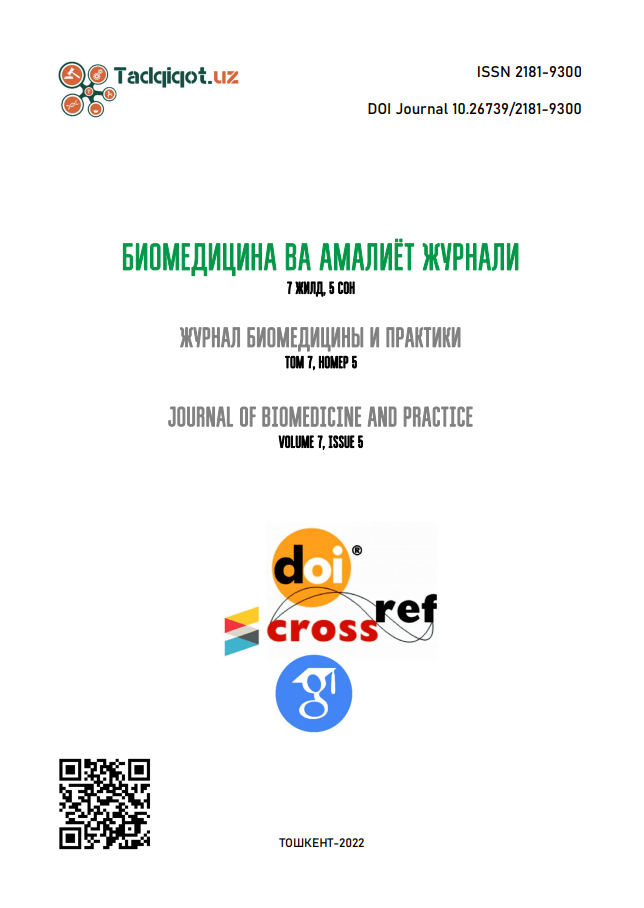NON-INVASIVE DIAGNOSIS OF FUNCTIONAL CHANGES IN THE GASTRIC UNDER THE INFLUENCE OF ENERGY DRINKS
Keywords:
enzyme immunoassay; pepsinogen, blood serum; rat; stomachAbstract
Objective: Evaluation of functional changes in the stomach under the influence of energy drinks by laboratory methods
Methods: The experiment was performed on 30 three-month-old white male rats weighing 130 ± 20 g. To obtain an experimental model, the Gorilla energy drink (ED) was administered intragastrically for 4, 8, 12 weeks through a plastic tube. After extraction, serum samples were stored in a refrigerator at -20°C until ELISA analysis. Laboratory study of serum pepsenogenes 1 and 2, tumor marker CA74-2 was carried out using special Russian-made kits for enzyme immunoassay (ELISA).Results: In acute poisoning, the average concentration of PGI in the blood serum of rats in the group that consumed ED for 4 weeks was 4.96 µg/l. During this period, the mean concentration of PGII in ED-fed rats was 2.18 µg/L, and the mean PGII/PGII ratio was 2.69. At the same time, we see that these three parameters were drastically reduced in rats chronically using ED: in the group treated with ED for 8 weeks, serum PGI decreased to 4.19 µg/L, PGII by 1.76 μg/l and the PGI/PGII ratio was 2.41. When using ED for 12 weeks, the content of pepsinogen I in the blood serum of rats decreased by 2.78 µg/l, pepsinogen II by 1.22 µg/l, and the PGI/PGII ratio by 2.2. Levels of the tumor marker CA 74-2 ranged from 0.2 to 4.02 U/ml in rats treated with ED for 4 weeks. In blood samples of rats using ED for 8 weeks, the levels of tumor markers ranged from 1.36 to 5.38 U/ml, and when exposed to ED for 12 weeks, the levels of tumor markers ranged from 2.1 to 24.15 U/ml. ml. In just 12 weeks in poisoned rats, it rose to 24.15 U / ml in 1 (9%) case.
Summary. Thus, in general, the determination of the level of PG is a reliable indicator of the presence of changes in the gastric mucosa in an atrophic or hyperacid state. In recent years, in addition, it has been confirmed that low levels of pepsinogens can be a predictor of the development of gastric cancer. It should be taken into account that the study of the oncomarker CA74-2 in the blood serum helps to determine the morphofunctional state of the stomach under the influence of ED. This is one of the indicators of changes in the gastric mucosa and may reflect a precancerous condition of the gastric mucosa. This approach is a non-invasive method for detecting precancerous diseases in the population and is essential in the screening process that selects them for the next stages of examination.
References
Белковец А.В. и соав. Oпыт неинвазивной диагностики атрофического гастрита в текущей клинической практике. //Бюллетень со рамн, том 33, № 4, 2013. С.71-76.
Белковец А.В. и соав. Неинвазивная диагностика фенотипа гастрита в клинической практике: анализ первой тысячи исследованний. //Экспериментальная и клиническая гастроэнтерология // выпуск 115 № 3 2015. C.26-30.
Зайцева А.А., Богданова Т.М. «Онкологические аспекты органов желудочно-кишечного тракта» ФГБОУ ВО «Саратовский государственный медицинский университет имени В. И. Разумовского Минздрава России, [Электронный ресурс] –URL: bogtanmih@mail.ru
Джураев М.Д., Худайбердиева М.Ш. Роль серологического опухоль-ассоциированного маркера СА-72-4 при ранней диагностике рецидива рака желудка. //Сибирский онкологический журнал. 2009. Приложение № 2. С. 63.
Решетников О. В., Курилович С. А., Рагино Ю. И., Молчанова А. Р., Сорокина Н. Н., Кротов С. А., Кротова В. А. Использование иммуноферментного анализа для выявления уровня пепсиногенов в крови. //Гастроэнтерология экспериментальная и клиническая №5/2013, C. 26-30.
Решетников О.В. и соав. Физиологическое и клиническое значение пепсиногенов желудка. // Клиническая медицина. № 3, 2014. C. 26-30.
Шалыгин Л.Д., Р.А. Еганян. Энергетические напитки — реальная опасность для здоровья детей, подростков, молодежи и взрослого населения. Часть 1. Состав энергетических напитков и влияние на организм их отдельных компонентов. //Профилактическая медицина, 1, 2016 10.17116. С. 56-63.
Mubarak R. Effect of Red Bull energy drink on rats’ submandibular salivary glands (light and electron microscopic study). //American Journal of Science, 2012, 8(1): P.366-372.
Raeesa A. Mohamed, Aly M. Ahmed, Tahani Ahmad Al-Matrafi, Ali H. AlRoalle, Musaad A. Alfayez, Deema M. Al-Okaiel, Ahmed F. El Fouhil, Muhammad Atteya, Energy drinks induce adverse histopathological changes in gastric and duodenal mucosae of rats //International Journal of Advanced and Applied Sciences, 5(2) 2018, Pages: 81-89.
Samloff M.I. // Gastroenterol. 1975. V. 69. P. 1196– 1200.
Samloff M.I. // Gastroenterol. 1982. V. 83. P. 204–209.
Sipponen P. // J. Clin. Gastroenterol. 2001. V. 32. P. 196–202.
Satoru T., Akira I., Hiroshi Y., Yuhkoh K. Serum Pepsinogen Levels in Normal and Experimental Peptic ulcer Rats Measured by Radioimmunoassay. // Chem. Pharm. Bull. 35 (4 )1515-1522(1987) / P.1015-1023.
Nargiza Yusupova, Oripov Firdavs, Eshqobilova Surayyo. Influence of energy drinks on individual systems of the human body //International Journal of Early Childhood Special Education (INT-JECSE) DOI:10.9756/INTJECSE/V14I5.899 ISSN: 1308-5581 Vol 14, Issue 05 2022/ P. 7176-7184
Nargiza Yusupova, Oripov Firdavs. Energy drinks. the composition of energy drinks and the effect on the body of their individual components /tjm - Tematics journal of Microbiology ISSN 2277-2952 Vol-6-Issue-1-2022/https://doi.org/10.5281/zenodo.6464588/P. 24-35/

